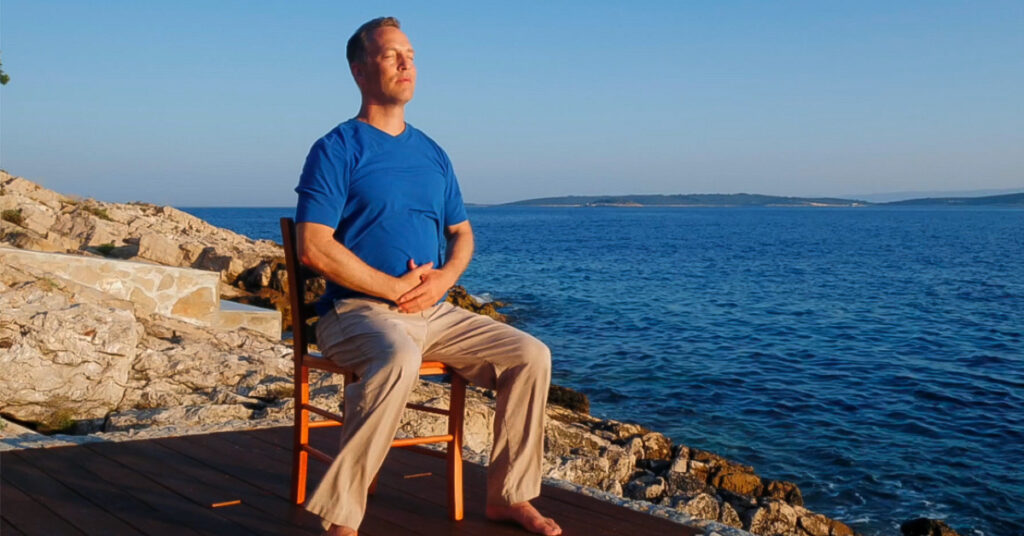
One of the wonderful things about Qi Gong is that there are so many ways you can practice! This means it’s accessible to everyone, regardless of whether or not someone has physical limitations.
Many of the Holden QiGong practices are standing practices, but we also realize that seated routines are more suitable for many individuals. Therefore, in this blog, we share a brief, seven-minute seated Qi Gong routine that you can enjoy from the comfort of your home. And just like many standing practices, this seated routine is designed to reduce stress and increase your energy levels.
Below, we’ve included a video of the practice as well as written instructions.
Before starting the practice, we suggest you read through the instructions so you can be fully focused on the seated Qi Gong routine once you start.
Spinal Cord Breathing
Start by sitting upright in a chair with your feet planted on the floor. Make loose fists with your hands and place them gently on your knees. Try to find a comfortable position in which you’re relaxed yet alert.
Begin taking slow, deep breaths. On your inhale, raise your hands up toward your face and bring them back as you gently arch your spine. Keep your tailbone in the same place and raise your chin as your entire spine bends slightly. At the top of your inhale, your spine should have a little arch as you gaze upward.
On your exhale, bring your elbows and hands down and contract your abdominal muscles so your spine bends forward. Bring your chin down so that you’re looking at your chest as you release the air from your lungs. Feel a slight bend in your spine as you exhale.
At the bottom of your exhale, begin inhaling again as you bring your hands up, arch your spine back, and move your chin upward. On your exhale, bring your hands and chin down and contract your abdominal muscles.
This exercise is called Spinal Cord Breathing because you’re synchronizing your breath with the movement of your spine. This is a wonderful exercise for activating your Qi and creating suppleness throughout your entire spine. Do this exercise for one to three minutes until you feel ready to move on to the next practice.
Qi Massage
After Spinal Cord breathing, return to a still position and take a couple of deep breaths as you sit upright in your chair. Then, make light, loose fists with your hands and gently tap on your chest, alternating between each hand.
Continue breathing as you tap on your chest and feel the energy activate in your heart center. Focus your mind on that part of your body and visualize the Qi becoming awakened within you.
After a minute or so, bring your fists to your lower back and begin tapping on your kidneys, just like you did on your chest. Your kidneys hold your essential life-force energy (Jing), so this exercise is wonderful for activating this potent form of Qi. Continue tapping for a minute or so before placing your hands on your knees again and returning to slow, deep breathing.
We call this exercise Qi Massage because tapping on your body “massages” your Qi and brings it to life.
Centering
This next exercise is designed to center your energy and help you experience a sense of groundedness and peace.
Start by putting both hands directly over your navel and rest one hand on top of the other. With your eyes closed, move one hand upward in a half circle until it’s directly above your head. Then, bring it down slowly as you move it directly along the midline of your body. Your hand should pass by your head, then your heart center, and finally return to your navel.
Next, bring your other hand upward in the same motion. Move it in a half circle until it’s directly above your head, and then bring it down past your head, heart, and back to your navel. Continue doing this exercise for one to three minutes, alternating between hands.
When your hand is directly above your head, visualize connecting to the universe (Tao). As you bring your hand downward, imagine the energy of the universe connecting to your spiritual consciousness in your head, then your emotional awareness in your heart, and finally, your physical essence in your Lower Tan Tien in your navel. By connecting these three important energy centers—spirit, heart, and body—your entire energy system becomes integrated and centered.
After a couple of minutes, bring both hands back to your navel and take a few deep breaths to further center your energy before moving on to the last exercise.
Pulling Down the Heavens
To begin this exercise, move your hands up in front of your body with your palms open and facing upward. Unlike the previous exercise, both your hands should move upward at the same time in synchronicity.
When your hands are directly above you, bring them down slowly with your palms facing toward your body. Once your hands have returned to your navel area, circle them upward again and repeat the movement.
As your arms move up, visualize your hands ‘scooping’ energy from the universe. When you move them downward, imagine you’re ‘pouring’ that energy over your body. Imagine that this energy is full of fresh, nourishing Qi.
This exercise is called Pulling Down the Heavens because you’re pulling the heavenly energy of the universe down over your being, invigorating your entire body with vitality. With each movement, imagine the energy of the universe cleansing your body of stress and anxiety and replacing it with a feeling of calm and relaxed energy.
After one to three minutes, bring your hands back to your lower abdomen, take a few more deep breaths to fully center the energy you just cultivated, and take that feeling with you into the rest of your day.
If you enjoyed this brief practice and want to learn more Qi Gong exercises, be sure to check out our Seated Qi Gong Learning Series program.
Try Another Seated Qi Gong Routine For Less Stress and More Energy
Our Seated Qi Gong Workout Learning Series Program is the perfect way to dive deeper into seated Qi Gong exercises. And just like the routine you just tried, this longer routine focuses specifically on practices that energize and strengthen your internal life-force energy.
Click on the banner below to learn more and deepen your practice today.
